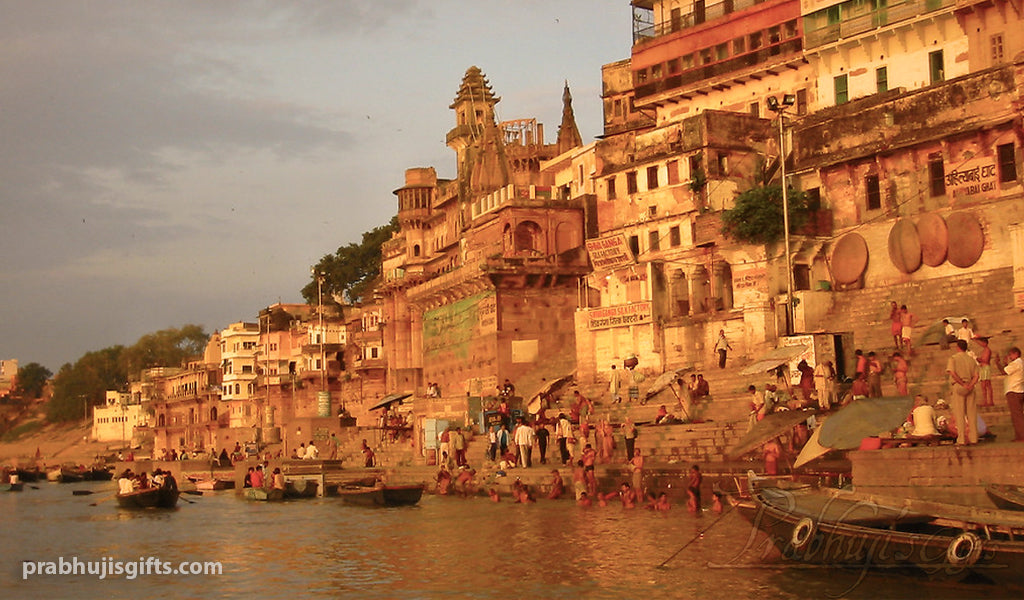 Many of us have heard about the Ganga, the famous river in India more commonly known in the West as the Ganges. Many have also seen pictures of thousands of people gathering on her banks during the Kumbha Mela when they bathe in her cold water. Therefore, many may be wondering – what is so special about this body of water that makes it different from any other river on the planet?
Many of us have heard about the Ganga, the famous river in India more commonly known in the West as the Ganges. Many have also seen pictures of thousands of people gathering on her banks during the Kumbha Mela when they bathe in her cold water. Therefore, many may be wondering – what is so special about this body of water that makes it different from any other river on the planet?
First let us mention some physical facts about this holy river.
The River Ganga springs from the ground in North India, in the high altitude of the Himalayas around 4,255 meters (14,000 feet). The people of ancient times observed its glacier that resembled an open mouth of a cow, and called the place Gomukh, or “the cow’s mouth.” Gomukh is situated at the base of a mountain range called Bhagirathi, commemorating King Bhagiratha who brought the Ganga to earth (we will tell this story later), and after whose name the northern part of the Ganga is named Bhagirathi.
From Gomukh, the Ganges River, which is called Bhagirathi at this geographical point, travels throughout the beautiful Himalayas, accepting small streams and rivers as they flow into Her until arriving at Dev Prayag, where another big and holy river called Alakanda merges into it. Together, they become the holy Ganga.
From Devprayag, the Ganga continues to flow through the Himalayas until She emerges from the mountains in the holy city of Rishikesh, which has been known for decade as a spiritual center.
From here, the Ganges River continues to the plains, crossing a large area of land from the north of India then towards the east, until it merges into the ocean at Ganga Sagar, in West Bengal.
Ganga, the Goddess River
Hinduism is comprised of various traditions, paths and beliefs that may seem very different in many ways, but there are a few key points on which all of those paths agree. One of these is that the Ganges River is holy—its origin is Divine—and it has the tremendous power to purify one’s soul and remove sins.
 Since Hindu scriptures describe the river as a Goddess, or divine energy, we refer to this incredible body of water as “She” who descended on earth in the form of a river for the benefit of living beings so that they will be able to purify themselves in Her waters.
Since Hindu scriptures describe the river as a Goddess, or divine energy, we refer to this incredible body of water as “She” who descended on earth in the form of a river for the benefit of living beings so that they will be able to purify themselves in Her waters.
Goddess Ganga is described as a beautiful woman, wearing a white sari (sometimes red) and sitting on a lotus flower, with a crocodile waiting at her feet and ready to serve as her vehicle. She has four hands, holding in one a lotus, in another a water pot and her two remaining hands are in the positions of blessings.
The ancient Puranas (holy scriptures that bring the highest spiritual truths through stories) describe the heavenly origin of the Ganga in various ways.
The Birth of Goddess Ganga (from the Bhagavata Purana)
Bali was a very powerful king who ruled the earth and acquired more and more power, until he managed to defeat the Devas (demigods) and conquered heaven. The Devas approached their patron, Lord Vishnu, asking him to restore their lordships in heaven.
Lord Vishnu, wanting to save them from their trouble and to diminish the pride of Bali, incarnated on earth as Vamana, a poor Brahmana dwarf boy. While Bali Maharaja was conducting a large sacrifice in order to acquire even more power, Vamana appeared in front of him and asked for a donation. Vamana, full of pride, told the short Brahmana that he will fulfill any request he makes. In reply, Vamana assured him that he is does not need much and that his only request is a piece of land that is the size of 3 of his steps. Bali, looking at the dwarf, laughed and granted his request. Vamana lifted his foot and suddenly grew immensely and with one step he covered all of the earth. With his second step he reached heaven, and then he asked Bali where should he put his third step, as he already covered the earth and heaven. Bali immediately understood that the Dwarf must be no other then Lord Vishnu and bowing down in front of him he offered his head as a resting place for the third step of the Lord.
When the leg of Vishnu-Vamana entered heaven, Lord Brahma took his water pot and washed his foot with water. From this water that washed the foot of the Lord, Goddess Ganga was born in heaven.
Ganga Descends on Earth
 There was a great king named Sagara, who had no less than 60,000 sons. He performed 99 horse sacrifices, a Vedic ceremony performed by kings in order to obtain power and a kingdom. Indra, the King of the Gods, was frightened by the results of his sacrifices, and fearing that King Sagara would become stronger than him, he attended one of the sacrifices and stole the sacrificial horse. Indra hid him in Patala Loka, the lower world, in the secluded ashram of Sage Kapila who was performing sacrifices there. King Sagara sent his 60,000 sons to find the horse. When the sons couldn’t find it anywhere on earth, they dug a big hole in the ground and went through it to Patala Loka. There they came to the ashram of Sage Kapila, and saw the horse grazing there while the sage meditated next to it. Thinking that the sage was the one who stole it and now pretended to be meditating, they became very angry. Screaming that they would kill the thief, they entered the ashram. The meditation of the sage was disturbed and he opened his eyes and his glance burned them all to ashes.
There was a great king named Sagara, who had no less than 60,000 sons. He performed 99 horse sacrifices, a Vedic ceremony performed by kings in order to obtain power and a kingdom. Indra, the King of the Gods, was frightened by the results of his sacrifices, and fearing that King Sagara would become stronger than him, he attended one of the sacrifices and stole the sacrificial horse. Indra hid him in Patala Loka, the lower world, in the secluded ashram of Sage Kapila who was performing sacrifices there. King Sagara sent his 60,000 sons to find the horse. When the sons couldn’t find it anywhere on earth, they dug a big hole in the ground and went through it to Patala Loka. There they came to the ashram of Sage Kapila, and saw the horse grazing there while the sage meditated next to it. Thinking that the sage was the one who stole it and now pretended to be meditating, they became very angry. Screaming that they would kill the thief, they entered the ashram. The meditation of the sage was disturbed and he opened his eyes and his glance burned them all to ashes.
When his sons had not returned, the king sent his grandson Amshumanta to see where they were and to retrieve the horse. Amshumanta also searched the entire earth and could not find anything. Then he entered Patala Loka through the big hole that his uncles had dug and arrived at Kapila’s ashram where he saw a big mountain of ashes and the horse grazing nearby. The sage told him about the offense and the punishment of all his 60,000 uncles. He also learned from the sage that the souls of the sons were trapped in the nether world as ghosts and would not be freed until death rights are performed to their ashes with the water of the heavenly river Ganga that would descend on earth for this purpose.
To bring Ganga to earth required great austerities that neither King Sagara nor his grandson Amshumanta were able to perform. Nor could Amshumanta’s son Dilipa do them and he died young, and thus the sins of the 60,000 undelivered souls multiplied and increased. On the day that the only son of Dilipa, Bhagiratha, who was merely 16 years old, received the throne, he found out that his ancestors were dwelling in a devastated and undelivered state, and that they would only be able to be delivered if Ganga is lowered to earth. He immediately put the kingdom in the hands of his ministers and went to the Himalayas to perform austerities. He spent many years in seclusion, enduring severe penance and prayer to Lord Brahma. At the end of these years, Brahma, pleased with his prayers appeared in front of him and asked for his wish. Bhagiratha asked Brahma to send Ganga to earth to purify the sins of his ancestors. Lord Brahma agreed, but asked Bhagiratha to pray to Lord Shiva to accept Ganga on his head when she falls from heaven because no one other than him will be able to bear her great force, which could destroy the whole planet.
Bhagiratha then performed further penance by living solely on air for one whole year, and by the end of this year Lord Shiva appeared before him and assured him that he will accept Ganga on his head when She descends.
Being thus assured, Lord Brahma sent Ganga to earth. Ganga, wanting to challenge the strength of Shiva, descended down in a great force. Lord Shiva waited for her there and trapped her water in his matted hair, and did not let it go. Bhagiratha again prayed to Lord Shiva and asked him to release Ganga. Lord Shiva agreed but said: “In order that the mighty Ganga will not destroy the earth, I will release her in seven separate streams, each one of them will flow in another direction, and only one will follow you.” Thus, further sanctified by Lord Shiva’s touch, Ganga’s seven streams finally flowed on earth, to the great delight of Bhagiratha. (It is said that Alakanda, the sacred river that joins Bhagirathi to become Ganga, is also one of Ganga’s seven streams released from Shiva’s hair.)
There was no end to the joy of Bhagiratha and he started to walk through the mountains while Ganga happily and calmly followed him. They continued this way and came out of the mountains to the plains.
In the plains there was an ashram of a sage named Jahnu. Bhagiratha stopped by the ashram to greet the sage. There, Ganga had again attained a naughty mood and, instead of waiting patiently for Bhagiratha, started exploring the ashram, flooding it with her water. In this way, Ganga disturbed the sage’s meditation and when he opened his eyes, he drank all of her water at once. Bhagiratha was horrified to see that all his efforts to bring Ganga down to earth had now disappeared and begged the sage to forgive Her and released Her for the sake of the poor souls of Bhagiratha’s ancestors. The sage agreed and let Ganga go out of his ears, thus sanctifying her water even further.
From here, Ganga once again followed Bhagiratha peacefully, continuing to the plains until reaching that huge hole dug by the sons of King Sagara in the ground. Ganga entered and filled it with her water, which is now called Saagara, or the ocean.
When they arrived at the ashram of Sage Kapila, Bhagiratha asked Ganga to wash the ashes of his ancestors and she happily did so, freeing them from their sin and sending them to heaven.
Since that day, Ganga stayed on earth, sanctifying the souls of countless people with her pure water and washing their impurities away.
The Glories of Ganga Water
 The Vedic scriptures and sages are never tired of glorifying and praising the power of Ganga’s water to purify and wash away people’s sins.
The Vedic scriptures and sages are never tired of glorifying and praising the power of Ganga’s water to purify and wash away people’s sins.
Shankaracharya, Bhaja Govindam:
Those who study (the) Gita, even a little, drink just a drop of water from the holy Ganga, worship Lord Krishna with love even once, Yama, the God of death has no control over them. ॥20॥
From Ganga Stotra by Shankaracharya
(1)
devi sureśvari bhagavati gańge tribhuvana-tāriṇi tarala tarańge śańkara-mauli-vihāriṇi vimale mama matir āstāṁ tava pada-kamale
O Goddess Ganga! You are the divine river from heaven, you are the savior of all the three worlds, you are pure and restless, you adorn Lord Shiva’s head. O Mother! May my mind always rest at your lotus feet.(2)
bhāgirathi sukha-dāyini mātas tava jala-mahimā nigame khyātaḥ nāhaṁ jāne tava mahimānaṁ pāhi kṛpāmayi mām ajnānam
O Mother Bhagirathi! You give happiness to everyone. The significance of your holy waters is sung in the Vedas. I am ignorant and am not capable to comprehend your importance. O Devi! you are full of mercy. Please protect me.








0 comments